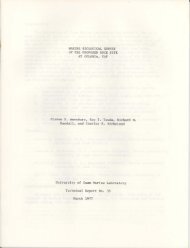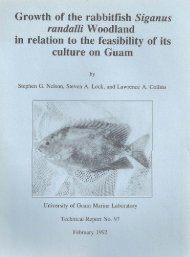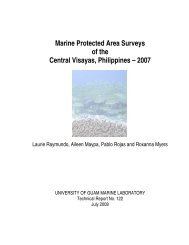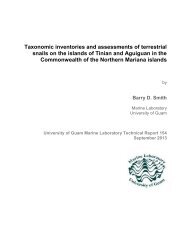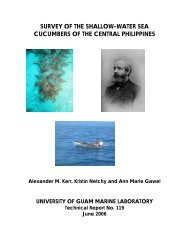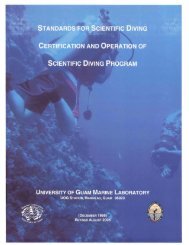Create successful ePaper yourself
Turn your PDF publications into a flip-book with our unique Google optimized e-Paper software.
120 COLLECTIONS FEOM MELANESIA.<br />
any one of the three collected by the officials of that great circumnavigating<br />
expedition.<br />
Though the term Plturechhins is due to L. Agassiz, and the specific<br />
name hothryoides to his incomplete comprehension of the Cidaris<br />
hotlinjoides of Klein and Leske, I have confined my " synonymy "<br />
to Alexander Agassiz's Report on the ' Challenger ' specimens, as<br />
it is there only that any such definite information is given as would<br />
enable a zoologist to recognize examples of the species. The result<br />
to which my own study of the specimens and of the definitions has<br />
led me has, I think, been essentially confirmed by the investigation<br />
into the structure of the test which, at my suggestion, Prof. Martin<br />
Duncan was allowed to make *.<br />
Looking, first of all, at the general form of the test, the observer<br />
is struck by its greater proportional height ; thus we find specimens<br />
with an absolute diam(!ter of 20, 18, or 17 millim. respectively<br />
having a proportional height of 58-5, 66-6, and 60. In<br />
no known examples of any other species of Temnopleurus is the<br />
proportional height more than 03-63 millim. f, and this is a rare<br />
case, which obtains with a specimen only 11 millim. wide. The<br />
examination of the dental apparatus did not shov/ any real point of<br />
difference between this species and T. hardwicl-ii. As in other<br />
species of this genus, the abactinal area is much more prominent<br />
in younger than in older specimens, while the characters of the<br />
furrows between the plates is only intermediate between the extreme<br />
condition presented by T. toreumaticus and that which is<br />
Been in the species just mentioned.<br />
As to the minute construction of the test. Dr. Duncan finds that<br />
" there is a generic relation between Temnopleurus and Pleurechmns,<br />
and the only important distinction is the absence of crenulation in<br />
the last-named type." To this crenulation or its absence Dr. Duncan<br />
attaches more importance than do many naturalists who have devoted<br />
themselves to this group, and he finds in consequence that " the<br />
classificatory position assigned by A. Agassiz to Plmrechinus in the<br />
' Eevision ' must be conceded, and it is a subgenus or section of<br />
Temnopleurusr Notwithstanding the weight of the authority of<br />
Agassiz and Dimcan, I am bound to say that I feel still the importance<br />
of the objections long ago urged by D'Archiac and HaimeJ,<br />
" Quant aux crenelures des tubcrcules, on sait que cette particularite<br />
n'a cgalement qu'une valeur tres-secondaire, puisqu'on la voit deja<br />
disparaitre dans une certaine portion du genre Cidaris, sans qu'on<br />
puisse decouvrir chez les especes a tubercules lisses aucune autre<br />
difference concomitante; " and that being so, I can find no reason<br />
which will justify the retention of a genus never very accurately<br />
defined.<br />
The largest specimen in the ' Alert ' collection has a diameter<br />
* Journ. Linn. Soc. (Zool.) xvi. p. 447.<br />
t P. Z. S. 1880, p. 424.<br />
X Anim. fo^s. de I'lnde, p. 202 (ISr^S). The student should be reminded<br />
that Prof. Martin (Notes Leyd. Mus. ii. p. 75) accepts the genus Plcurcchinus.





